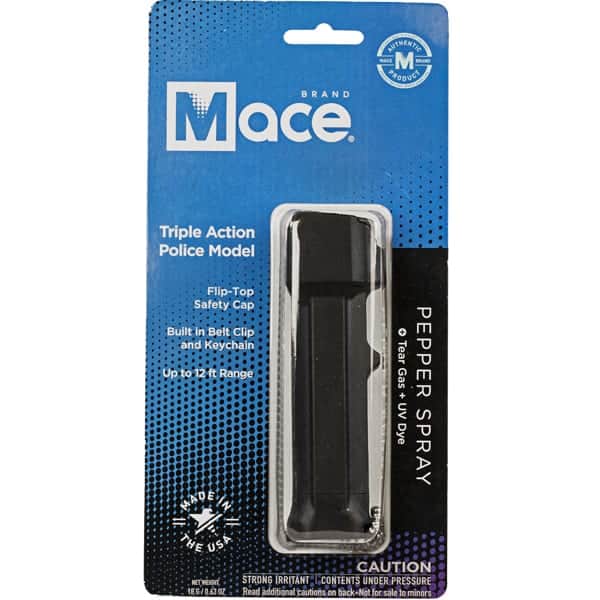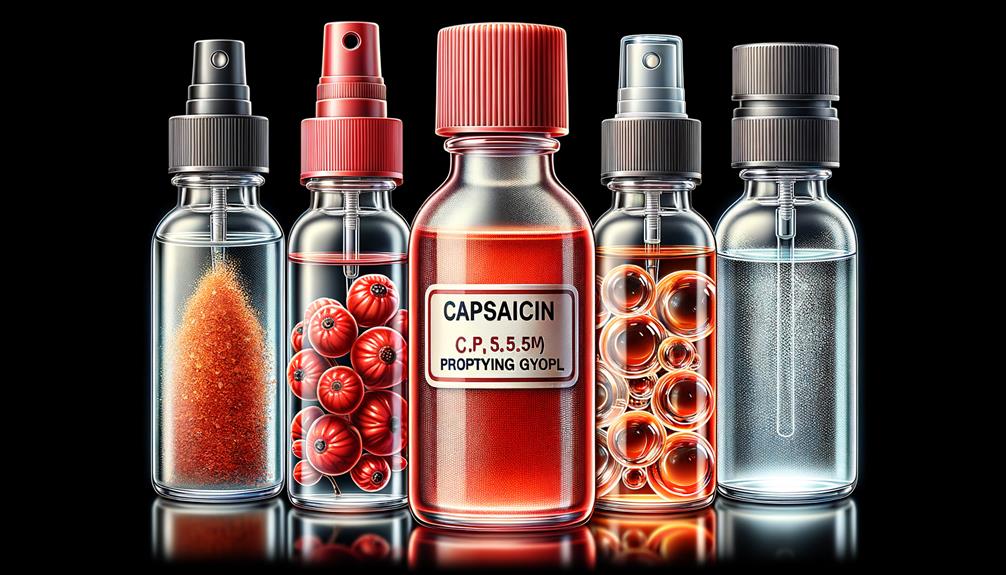
Brainstorm Security Shop

For Orders Over $199

On Any Of Our Products

Details On Refund Page
When considering the composition of mace spray, it’s crucial to understand how each ingredient plays a vital role in its effectiveness. From capsaicin’s incapacitating effects to the strategic use of solvents and propellants, every component contributes to the spray’s functionality. But, what about the interaction between these ingredients? How do they work together to create a potent and reliable self-defense tool? Let’s uncover the chemistry behind mace spray ingredients and explore how their synergy can make all the difference in critical situations.

Capsaicin, the primary active component in mace spray, is a potent chemical compound responsible for the intense burning sensation upon contact with skin or mucous membranes. This fiery sensation is a crucial aspect of its self-defense properties.
When capsaicin comes into contact with the skin, it binds to pain receptors, particularly the transient receptor potential vanilloid 1 (TRPV1) ion channels, triggering a burning sensation. This reaction is part of the body’s defense mechanism against potential harm, acting as a warning signal.
In self-defense scenarios, capsaicin can cause temporary incapacitation, giving individuals an opportunity to escape dangerous situations. The burning sensation is a result of capsaicin’s ability to disrupt the normal functioning of sensory neurons, leading to pain and irritation.
Understanding the mechanisms by which capsaicin induces this sensation is crucial for maximizing its effectiveness in self-defense applications. Its ability to trigger a powerful burning sensation makes capsaicin a valuable component in mace spray formulations designed for personal protection.
An essential component in mace spray formulations, solvents play a crucial role in aiding the dispersion of capsaicin for effective delivery upon use. Solvents are carefully selected based on their ability to dissolve capsaicin and other active ingredients, ensuring a homogeneous mixture that can be easily dispersed when the spray is activated.
Dispersion methods involve the use of solvents to break down capsaicin particles into smaller droplets, enhancing their spread and coverage upon contact with the target. Through chemical reactions between the solvent and capsaicin, the active ingredient is dissolved and evenly distributed throughout the solution, ready for deployment.
Choosing the right solvent is critical as it directly impacts the spray’s effectiveness. Factors such as evaporation rate, compatibility with the propellant, and ability to maintain stability over time are all considered in solvent selection. The proper solvent ensures that the capsaicin remains in a state where it can be readily dispersed, maximizing the spray’s potency and reach.
Selecting the appropriate propellant is crucial for enabling the spray mechanism in mace formulations. Propellants play a vital role in ensuring the efficient deployment of the mace spray for self-defense purposes. The propellant efficiency directly impacts the spray effectiveness, determining how far and wide the mace spray can reach its target.
Propellants are responsible for expelling the active ingredients from the canister, creating a mist or stream that can incapacitate an attacker. The choice of propellant must balance factors such as pressure, temperature, and compatibility with the other ingredients in the formulation. Propellants commonly used in mace sprays include compressed gases like nitrogen or carbon dioxide, as well as hydrocarbons like isobutane or propane.
Efficient propellants contribute to the overall effectiveness of the mace spray by ensuring a consistent and powerful spray pattern. When formulating mace sprays, manufacturers carefully consider the propellant’s characteristics to optimize the product’s performance in real-world self-defense scenarios.
Efficient UV marking dye serves as a distinctive identification feature in mace sprays, aiding in the tracking and identification of potential assailants. This identification technology incorporates a specialized dye that’s invisible under normal lighting conditions but becomes highly visible under ultraviolet (UV) light.
When sprayed on an individual, the UV dye marks the assailant’s skin and clothing, making it easier for law enforcement to identify and apprehend them after the incident. This safety measure enhances the effectiveness of mace sprays by providing a valuable tool for forensic investigations.
The UV marking dye is formulated to adhere to the skin and clothing of the target, ensuring that it remains in place for an extended period, even if the assailant attempts to wash it off. This feature is crucial for aiding in the prosecution of individuals involved in criminal activities.
Additionally, the UV dye acts as a deterrent, as potential attackers are aware of the identification technology present in mace sprays, making them think twice before committing a crime.
Consider incorporating specific inert ingredients in the formulation to enhance the overall effectiveness of the mace spray product. Inert ingredients play a crucial role in the formulation effectiveness by influencing chemical interactions within the solution. These ingredients can improve the stability, dispersal, and adhesion properties of the spray.

By carefully selecting inert ingredients that are compatible with the active components, you can optimize the product’s performance and ensure consistent results.
When formulating mace spray, it’s essential to adhere to safety regulations regarding the use of inert ingredients. These regulations are in place to protect users and the environment from any potential harm.
Additionally, considering the environmental impact of the inert ingredients is crucial to develop a sustainable product. Choosing environmentally friendly inert ingredients can minimize the ecological footprint of the mace spray while maintaining its efficacy.
To ensure the longevity of mace spray products, it’s imperative to incorporate shelf life preservatives into the formulation. Shelf life preservatives play a crucial role in maintaining the effectiveness of mace spray over time. These preservatives help prevent degradation of active ingredients, ensuring that the spray remains potent and ready for use when needed.
Storage recommendations are essential to maximize the effectiveness of shelf life preservatives. Mace spray should be stored in a cool, dry place away from direct sunlight and extreme temperatures. Expiration dates should always be checked, and expired products should be disposed of properly.
Considering the environmental impact of mace spray products is crucial. When disposing of expired or unused mace spray, follow local regulations and guidelines for hazardous waste disposal. Proper disposal methods help prevent environmental contamination and ensure the safety of both humans and wildlife.

In conclusion, mace spray ingredients like capsaicin, solvents, propellants, UV marking dye, inert ingredients, and shelf life preservatives combine to create an effective self-defense product. Each component plays a crucial role in the formulation, from causing temporary incapacitation to ensuring longevity and potency.
Understanding the synergy of these ingredients is key to maximizing the efficacy of mace spray for personal protection.

Brainstorm Security Shop
1867 Caravan Trail
Ste 105
Jacksonville, FL 32216
Call us toll free: (800) 859-5566